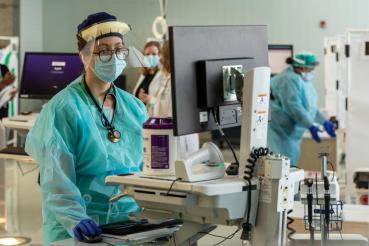You may have seen the latest COVID-19 numbers in Illinois and thought you were reliving parts of 2020. Unfortunately, new COVID-19 cases in Illinois have been on the rise since late October. That could mean we may have another surge this holiday season, says John Segreti, MD, an infectious disease specialist and medical director of infection control and prevention at Rush University Medical Center.
As of last Friday, the average number of new COVID-19 cases in Illinois jumped 25% compared with the previous week. Nationally, the average number of new COVID-19 cases rose 16% last week compared with the previous week, according to the Centers for Disease Control and Prevention.
Segreti says COVID-19 cases tend to follow a three-month cycle of rising and falling. “The number of cases is going up, and if the past is any predictor of the future, cases will likely continue to go up for the next four to six weeks,” he says. “Then they will plateau and then start to come down again for four to six weeks.”
Still, Segreti is cautious about making predictions about COVID-19. “There’s really no way to predict when a COVID-19 surge is going to start or when it’s going to end,” he says.
COVID-19 cases in Illinois are not as bad as last year
Some good news: Daily COVID-19 cases in Illinois are still below 6,000. About a year ago during the fall surge, daily cases were twice that number.
Illinois is one of several Midwestern states experiencing a rise in COVID-19 cases while many Southern states are seeing fewer cases. “In Florida, the number of cases is declining, but in Michigan, it’s a lot worse than it is in Illinois,” Segreti says.
Globally, too, the spread has been unpredictable: Japan has not seen a recent COVID-19 surge, but in Europe, cases are going up, he adds.
COVID-19 hospitalizations are also on the rise
The number of people in Illinois hospitalized with COVID-19 has also increased during the past few weeks. “It’s starting to go up but fairly slowly,” Segreti says. Currently at Rush, about 25 patients are hospitalized for COVID-19.
Yet current hospitalizations from COVID-19 are still well below the surges of 2020, Segreti says. In February through April 2020, Rush cared for about 170 patients hospitalized for COVID-19 on a typical day. And during the surge in the fall of 2020, Rush staff treated up to 50 hospitalized patients for COVID-19 each day.
Currently, about 80% of those hospitalized at Rush for COVID-19 are unvaccinated, Segreti says. A CDC study found that unvaccinated people with COVID-19 are more than twice as likely to receive emergency care or be hospitalized, compared with vaccinated people with COVID-19. The study also found that those who are unvaccinated are seven times more likely to die than those who are vaccinated.
Several factors may be fueling a surge
As of Nov. 22, about 58% of the population in Illinois is fully vaccinated, while nearly 64% have received at least one dose, according to the Illinois Department of Public Health. So why are cases and hospitalizations rising in Illinois despite the vaccination rate steadily increasing?
Segreti suspects that a number of factors have contributed to the recent rise in COVID-19 cases and hospitalizations in Illinois. These include the millions of people in the state who remain unvaccinated as well as the broader population becoming less vigilant about masking and social distancing. He also believes the coronavirus could be changing in a way that makes it easier to spread at the same time the population’s immunity due to natural infections and early vaccinations could be decreasing.
The pandemic will be with us for a while
Unfortunately, Segreti believes that COVID-19 will continue to be part of our lives for some time. “It doesn’t look like we’re close to being done with the pandemic, and it doesn’t look like COVID-19 will ever go away,” he says. “But what we’re hoping is that it will turn into a seasonal coronavirus that won’t cause the number of hospitalizations and deaths that it did in the beginning.”
In some countries like Germany and the United Kingdom that have higher vaccination rates than the United States, there are encouraging signs that this is already happening. “In those countries, we’re seeing COVID-19 cases going up but deaths aren’t going up at the same rates, and that’s what we would want to see,” Segreti says. “The vaccines are not 100% effective, and immunity does wane over time. But the main reasons to get vaccinated are to prevent serious infection, hospitalizations and death. And the vaccines seem to be doing that.”
We can do our part to reverse the trend
To help our COVID-19 numbers trend downward, Segreti recommends getting vaccinated or getting a booster if you are due.
According to the CDC, all adults can now receive a Pfizer or Moderna booster if it has been at least six months since they completed their primary two-dose series with the Pfizer or Moderna vaccines. Adults who received the single-dose Johnson & Johnson shot at least two months ago may get a booster with any of the COVID-19 vaccines available.
In addition, children ages 5 and older are now eligible for the Pfizer vaccine.
Beyond getting the shots, Segreti recommends staying vigilant with masking and social distancing in public to guard against COVID-19, now and after the holidays.
“We have to be ready for it by doing what we can to protect ourselves, our families and our coworkers,” he says.
If you have not yet received a COVID-19 vaccine or would like to get a booster, you can schedule an appointment to receive one now at our vaccine clinics.




